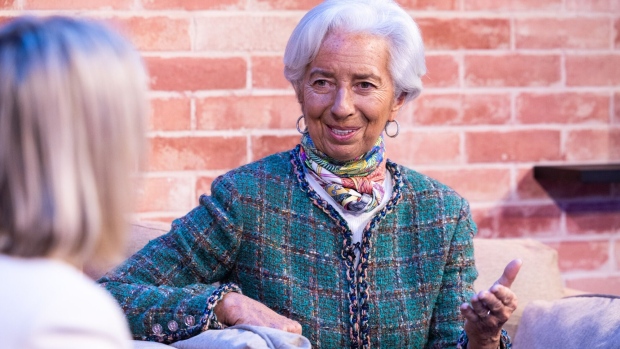Jan 18, 2024
ECB Officials Converge Around June to Start Cutting Rates
, Bloomberg News

(Bloomberg) -- European Central Bank officials who until recently had been wary of even discussing interest-rate cuts now look increasingly open to commencing them in June.
Speaking this week in Davos, President Christine Lagarde and several of her colleagues dismissed investor bets on reductions before then. But they signaled the chance of a move around mid-year, when they’ll know more about inflation, wages and the stuttering economy, as well as the harm to supply chains by Yemen’s Houthi rebels.
Quizzed at Bloomberg House on a summer rate cut, Lagarde described the prospect as “likely.” While cautioning that uncertainty remains high and not all indicators are where the ECB would like them to be, her message nudged markets a little and was interpreted as a clear indication of intent.
“The statements came as a bit of a surprise — when the ECB president says something like that, it’s like a pre-commitment,” said Carsten Brzeski, global head of macro at ING. “After the statements, a rate cut in June seems very likely.”
With Thursday marking the start of the weeklong quiet period before the ECB’s next policy meeting, there’ll be no more rate speak for a few days, and officials may be cagey about offering concrete guidance when they release their statement on Jan. 25.
That will leave investors pouring over the latest remarks, which in Lagarde’s case included a warning that excessive easing bets could complicate the goal of reaching 2% inflation by loosening financial conditions.
Earlier this week, Bundesbank chief Joachim Nagel said the “summer break” may be an appropriate time to consider a move, having previously called talk on the topic premature.
The effect of their comments on markets was amplified by strong US economic data, alongside an overshoot in UK inflation that prompted traders to soften wagers for rate cuts by the Bank of England.
What Bloomberg Economics Says...
“We forecast a rate cut at every meeting this year from June. That would total 125 basis points in 2024 and is more than the expectations of economists surveyed by Bloomberg News of 100 bps and in line with expectations in the financial markets. The ECB is universally expected to leave rates unchanged in January.”
—David Powell, senior economist. For full note, click here
For the ECB, money markets are now almost evenly split between five quarter-point reductions in 2024 and six. They anticipate 138 basis points of easing by year-end with an 80% chance of the first cut coming in April.
That would require an abrupt change of gear in Frankfurt, but such a shift remains possible, according to Denis Lehman, securities chief investment officer at Swiss Life Asset Managers France.
“They’re telling us that our bets are too aggressive but it’s our job, it’s our purpose,” he said. “Our position is that the correction will come, and sooner rather than later.”
Among ECB officials, though, it’s really only Portugal’s Mario Centeno who’s been vocal about the possibility of acting before the results of early-year wage bargaining are in — likely around May.
And his Austrian counterpart — arch-hawk Robert Holzmann — has warned that rate cuts aren’t guaranteed at all this year if tensions such as those gripping the Middle East escalate further.
For the most part, policymakers appeared to be on the same page.
Speaking in Vienna, Lithuania’s Gediminas Simkus said he’s “less optimistic than markets about rate cuts in March or April,” though a move during the course of the year was likely. Slovenia’s Bostjan Vasle said it’s “absolutely premature to expect the first cuts at the beginning of the second quarter.”
An account of the ECB’s last policy meeting showed such sentiment was broad-based.
“It was widely felt that market expectations reflected significant optimism and were inconsistent with the outlook in the staff projections, with respect to both the inflation outlook and the rate path embodied in the technical assumptions,” the ECB said.
That puts the focus firmly on June, when the ECB will unveil new quarterly projections for inflation and economic growth that often underpin key policy decisions.
While inflation sank in 2023, it actually picked up a little in December, albeit for statistical reasons that should prove temporary. Meanwhile, the euro zone continues to flirt with a recession, which could further soothe price pressures if it materializes.
Germany, the region’s No. 1 economy, revealed this week that annual output in 2023 shrank for the first time since the pandemic, with only a weak rebound likely at best.
Thursday will bring an account of the ECB’s last decision, while closely watched surveys of purchasing managers next week will offer a reading on economic activity. Those releases are unlikely to jolt policy, however, with borrowing costs set to be held at 4% and policymakers demanding a much fuller picture before altering course.
Chief Economist Philip Lane cautioned at the weekend against “too rapid a recalibration” in rates. With unemployment recently hitting a record low despite the unprecedented tightening he urged patience before the wage figures arrive.
“By our June meeting, we will have those important data,” he said.
--With assistance from Julien Ponthus, Jana Randow and James Hirai.
(Updates with account of last policy meeting in 16th paragraph.)
©2024 Bloomberg L.P.






